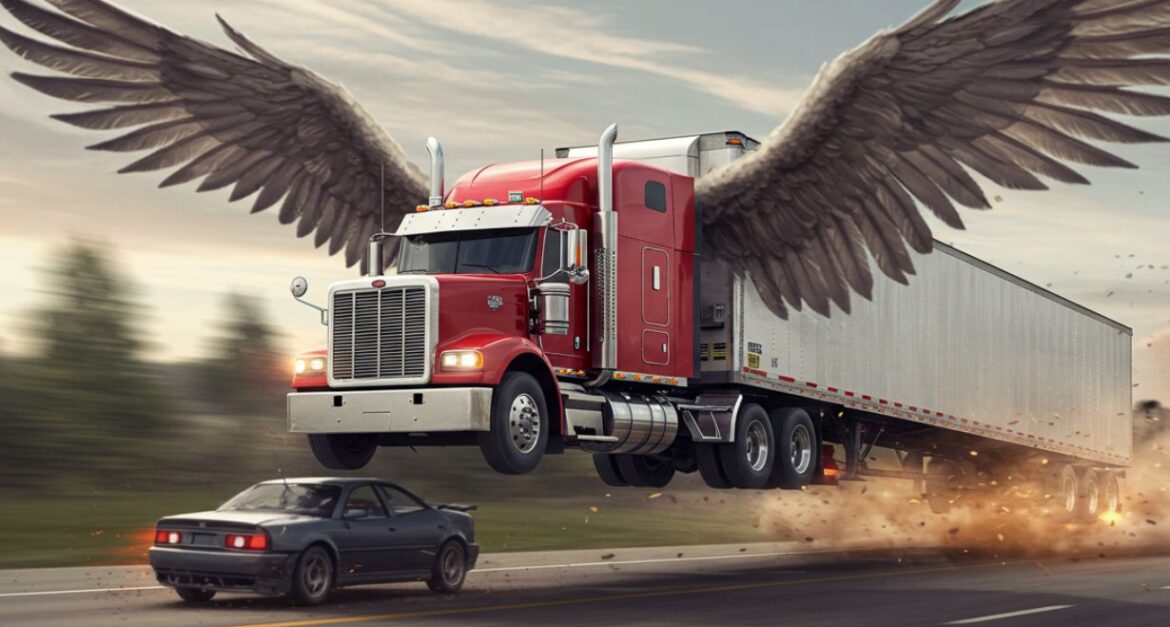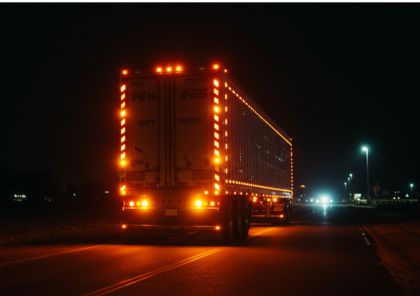
How to Avoid Underride Crashes as an Onwer Operator
Ain’t nobody got time to read? How about listen while driving?
Staying Ahead of Underride Crashes: A Truck Driver’s Guide to Safe Roads
Let’s face it: truck driving is an absolutely critical profession. You move the goods that sustain our communities, keep our shelves stocked, and literally drive the economy. But, while being a truck driver has its rewards, it also comes with serious responsibilities, especially regarding fatal crashes and other road risks. One of the most catastrophic—and often preventable crashes—is the underride crash, also known as a run under crash. This occurs when a smaller vehicle ends up sliding under a large truck or trailer, bypassing all the usual car safety features like airbags and seat belts.
Over the years, numerous efforts—such as legislative initiatives, advanced technology, and updated safety policies—have aimed at reducing underride incidents. Yet, effective prevention often starts with the truck driver. So, in this blog post, we’re going to focus on your role in minimizing underride dangers to yourself and everyone else on the road. We’ll share actionable insights, comparisons, and a few real-world examples to show how a few mindful practices can go a long way in saving lives.
What Exactly Is an Underride Crash?
An underride crash happens when a passenger vehicle collides with the rear or side of a truck and slides underneath its trailer. Because the front end of most cars is engineered to handle frontal impacts, if they instead “go under” a raised trailer, the vehicle’s built-in protective structures are bypassed. The consequences can be devastating or fatal. According to the Insurance Institute for Highway Safety, these crashes are especially severe because the smaller car’s occupant compartment is directly hit by the trailer.
Run Under Crash vs. Other Collisions
- Run Under Crash (Underride Crash): High chance of catastrophic injury because of direct intrusion into passenger space.
- Typical Rear-End Crash (Car-to-Car): Vehicle crumple zones and airbags can mitigate impact, often leading to survivable injuries at moderate speeds.
Simply put, a few inches in vertical clearance can mean the difference between a typical rear-end accident and a fatal collision. That’s why preventing an underride crash is paramount.
Why Truck Drivers Play a Vital Role
Driving a big rig doesn’t just give you a paycheck—it also gives you enormous influence on traffic safety. You can be proactive on the road, adapting your behavior and making decisions that prevent these catastrophic underride incidents. While there’s been talk about designing more resilient underride guards and technology solutions—like collision-avoidance systems—it all starts with you, the person behind the wheel of a truck.
Key Strategies to Stay Ahead of the Curve
| Key Factor | Technology Solutions | Driver Actions | Impact on Underride Crashes |
|---|---|---|---|
| Collision Avoidance | Radar sensors, Automatic Emergency Braking (NHTSA) | Maintain safe following distance & brake gently | High reduction potential |
| Visibility | LED trailer lights, reflective tape (FMCSA) | Clean & check lights/reflective tape regularly | Prevents nighttime/low-light crashes |
| Underride Guards | Rear and side guards that meet enhanced standards (IIHS) | Inspect guards regularly; report any damage | Physical barrier against run-under |
Let’s talk about practical, on-the-road things you can do to dramatically lower underride risks.


1. Keep Your Trailer Visible
Being “large” doesn’t always mean being “visible.” Twilight, nighttime, fog, or even rain can hide the outline of your trailer from smaller vehicles. That’s why:
- Clean Reflective Tape & Lights: Grimy or faded tape drastically reduces visibility. As per FMCSA guidelines, regularly check that none of your reflective areas are covered in mud or damaged.
- Early Use of Hazards: If you’re stopping or even slowing significantly on the highway, switch on your hazard lights sooner rather than later. This ensures oncoming traffic sees you in time.
A quick wipe-down of reflective surfaces during rest stops can make the difference between an obvious presence on the road and a deadly surprise for that approaching driver.
2. Master Defensive Driving
Defensive driving means anticipating not just your next move, but the potential mistakes of others:
- Keep a Buffer: Maintaining a safe distance in front of you ensures you don’t brake abruptly, causing motorists behind to slam into your rear. This helps avoid a run under crash scenario.
- Check Mirrors Frequently: Your trailer’s blind spots are notorious. Frequent mirror checks help you catch cars lingering alongside, especially crucial during lane changes or wide turns.
- Mind the Weather: Rain, fog, and snow reduce stopping distances for everyone. If the roads are slick, it’s harder for a car behind you to stop, heightening the risk of a rear underride if you brake suddenly.
According to the Federal Motor Carrier Safety Administration (FMCSA), these simple vigilance techniques greatly cut down on preventable crashes.
3. Give Yourself Room to Stop Gradually
Hard stops are a major culprit in fatal crashes, especially when a car following you has just a fraction of a second to react. If you’re on a busy highway and you suddenly have to slow down:
- Ease Onto the Brakes: Signaling and lightly braking before a full stop gives the driver behind you more time to notice and reduce speed.
- Expect the Unexpected: Look ahead for merging cars, traffic slowdowns, or on-ramps where sudden braking might be needed. This gives you a chance to start braking earlier.
4. Check Your Underride Guards
Even though technology typically focuses on electronic systems, basic underride guards (the steel bars at the back of your trailer, often referred to as “Mansfield Bars”) have been mandatory on most trucks since the late 1990s. But they only work if they’re properly maintained:
- Inspect for Rust or Damage: It’s easy to miss a small dent, but that imperfection can mean a guard fails during a collision. A quick walk-around and inspection is always a good idea.
- Report Issues Promptly: If you see significant wear, tear, or missing fasteners, let your maintenance team or fleet manager know immediately.
The Insurance Institute for Highway Safety (IIHS) found that robust guards can be highly effective in stopping a smaller car from sliding under a trailer, but only if they’re up to spec.
References, Credibility & Further Reading
Throughout this article, we’ve integrated authoritative sources, including agencies like the FMCSA and NHTSA, as well as research bodies like the IIHS. By following guidelines from these organizations, you’re not just ticking boxes; you’re actively taking control over potential hazards on the highway.
Final Thoughts: Staying Proactive and Saving Lives
One could look at underride crashes, or run under crashes, purely as a vehicle design or legislation issue. But every day, truck drivers—like you—are out there making instantaneous decisions that could very well be the difference between a minor fender-bender and a fatal crash. Yes, technology (like collision-avoidance systems) and safety policies (like stricter underride guard rules) play a massive part in reducing these tragedies. However, the most important safety feature in the truck is you, the driver, armed with awareness, defensive driving skills, and an eye for equipment maintenance.
The road to ending underride crashes may be long, but every mindful check of reflective tape, every extra second given to brake gradually, and every double-check of a blind spot is another step toward preventing devastating collisions and saving lives—yours and others on the road.
Stay informed, stay vigilant, and keep trucking safely!
FAQ about Underride Crashes
1: What is an underride crash?
2: What are the main causes of underride crashes mentioned in the article?
* Limited visibility of the truck/trailer: Especially at night or in adverse weather conditions, if the truck's conspicuity tape or lighting is inadequate or dirty.
* Truck maneuvers: Such as a truck backing up, making a wide turn across traffic lanes, or being parked on the roadside without adequate warning.
* Issues with underride guards: Missing, damaged, or poorly maintained underride guards on the truck/trailer.
3: What can truck drivers do to help prevent underride crashes?
* Defensive driving: Being aware of surrounding traffic, avoiding sudden maneuvers, and using turn signals well in advance.
* Safe parking practices: Choosing well-lit and safe areas to park; if parking on a shoulder is unavoidable, using hazard lights, flares, or reflective triangles as required.
* Pre-trip and post-trip inspections: Checking the condition of underride guards and reporting any damage or issues immediately.
* Being cautious during turns and backing: Ensuring clear space and using spotters if necessary.